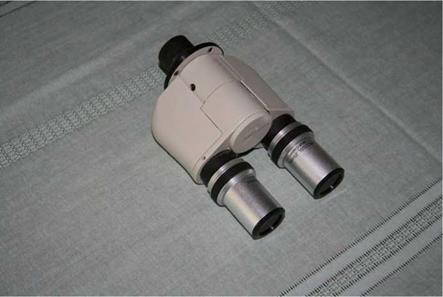The Binoviewer Option
|
Fig. 2.21 The binoviewer. Courtesy of the author |
The majority of telescope owners make their observations through an eyepiece using one eye. The human brain is designed to process visual images through two eyes. There are two options for viewing the Moon, the planets and stars with two eyes. One is REALLY expensive – binocular telescopes. The other option is relatively affordable – the binoviewer. The binoviewer uses a system of prisms to split the single light path of a telescope into two separate light paths to two eyepieces. This beam-splitting fools the eyes and the brain into thinking it is seeing an object in stereo. The results are spectacular when viewing the Moon. At certain high magnifications, and by allowing the Moon to drift through the field-of-view, the observer gets the sensation of orbiting the Moon and seeing the view that the Apollo command module pilot would see in orbit. With both eyes open, the lunar landscape seems to glide smoothly past. Even when tracking, the lunar landscape seems to take on three dimensions. The downside to owning a binoviewer is threefold:
• There is a slight light loss using a binoviewer because of the additional light splitting optics. But for a bright object like the Moon, this is not a problem. For planetary views, the light loss is not of great impact. Deep sky observing can be problematic, especially with dim objects.
• There is the additional expense of the binoviewer and buying two of every eyepiece. And you are limited to 1.25 in. sized eyepieces.
• Many telescopes do not have enough in-focus to accommodate a binoviewer. SCTs and Maks focus by moving the primary mirror and binoviewers work well with these types. Some refractors are manufactured with shorter tubes to accommodate the binoviewer, and provide extension tubes to use for mono viewing. Many binoviewers have an optional Barlow-like attachment to allow focusing with other types of telescopes, which limits the low power magnification range.











